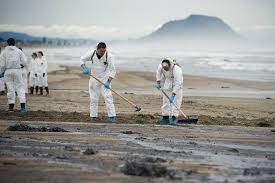A diesel fuel spill can be a hazardous and environmentally damaging incident that necessitates a swift and well-organized cleanup procedure. Proper response and containment are essential to prevent the spill from spreading and causing long-term harm. In this article, we outline a comprehensive diesel fuel spill cleanup procedure to ensure safety, minimize environmental impact, and meet regulatory requirements.
1. Immediate Response and Assessment:
- The first step is to assess the situation and determine the extent of the spill. Identify the source and any potential risks to human health or the environment.
- Isolate the spill area to prevent unauthorized access and further contamination.
- Notify the relevant authorities, including the local environmental agency and emergency responders if the spill is significant.
2. Safety Measures:
- Protect the safety of personnel involved in the cleanup. Ensure they wear appropriate personal protective equipment (PPE), including gloves, safety goggles, and respiratory protection if necessary.
- Adequate ventilation should be provided if the spill has occurred in an enclosed space to prevent the buildup of diesel fuel vapors.
3. Spill Containment:
- Use absorbent materials like absorbent pads, booms, or socks to contain the spill. Place these materials around the perimeter of the spill to prevent it from spreading further.
- Ensure that the containment materials are compatible with hydrocarbons and are capable of absorbing diesel fuel effectively.
4. Spill Recovery:
- Absorb the spilled diesel fuel using absorbent materials like absorbent pads or granular absorbents. Place these materials over the spilled fuel to soak it up.
- Collect the saturated absorbents in designated containers for proper disposal. It’s important to use the appropriate containers to prevent leaks.
5. Cleanup and Decontamination:
- Clean affected surfaces with soap and water to remove any residual diesel fuel. Avoid using high-pressure water jets, as these can disperse the fuel and create more environmental damage.
- Decontaminate any equipment or tools used in the cleanup to prevent recontamination. Clean them thoroughly to ensure they are free from diesel fuel residues.
6. Proper Disposal:
- Collected absorbents and contaminated materials must be disposed of properly in accordance with local, state, and federal regulations. Diesel fuel is considered hazardous waste, and it must be treated and disposed of appropriately.
- Ensure that waste disposal follows all environmental and regulatory guidelines, and maintain detailed records of the disposal process.
7. Final Site Remediation:
- After the initial cleanup, assess the site to determine if any residual contamination remains. Soil and groundwater sampling may be required to confirm that all diesel fuel has been removed.
- If contamination persists, a remediation plan should be implemented. This could involve excavating and removing contaminated soil or installing groundwater remediation systems if the fuel has leached into the groundwater.
8. Environmental Impact Assessment:
- A post-spill environmental impact assessment may be necessary to evaluate the extent of ecological damage. It will help determine if any long-term monitoring or restoration efforts are needed.
9. Documentation and Reporting:
- Document all aspects of the spill response, including actions taken, materials used, and quantities of diesel fuel recovered.
- Report the spill to the appropriate regulatory authorities, providing them with comprehensive records of the cleanup efforts.
10. Prevention and Training:
- Implement preventive measures to reduce the risk of future spills. This includes regular equipment maintenance, employee training, and the use of secondary containment systems where applicable.
- Ensure that employees are adequately trained in spill response procedures and emergency protocols to enhance preparedness and minimize the impact of potential future spills.
In conclusion, a well-structured diesel fuel spill cleanup procedure is crucial for protecting the environment and ensuring the safety of personnel involved in the response. Effective containment, recovery, and proper disposal are essential to minimize the environmental impact, while comprehensive documentation and reporting are necessary to meet regulatory requirements. Prevention and training play a vital role in reducing the likelihood of future spills and ensuring a swift and effective response when they do occur.
Check out DHI Excavations for more information.





